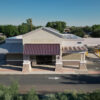Article originally posted on Costar
In another sign of the strength of the U.S. consumer and the resiliency of brick-and-mortar retail, in-store retail sales per square foot rose to records across most major categories in the first quarter, according to data compiled by Datex Property Solutions and reported by the International Council of Shopping Centers, or ICSC.
The measure, long the gold standard for evaluating the operating performance of physical retail space, comes as ICSC begins its annual trade show in Las Vegas Monday in an environment in which the pandemic appears to be easing.
For the 12-month period ending March 2022, 12 of 19 retail categories reported a record level of sales per square foot. Categories seeing the greatest uptick include fast food, beauty supplies, specialty food and specialty retail, which is a category that includes retailers focused on a specific retail vertical, such as books, party supplies, backpacking or devices. Of the seven categories not sitting at record levels, six remain below 2019 sales figures, while one, craft retailers, is above its 2019 sales level but below the elevated sales recorded in 2020, during the height of the pandemic.
Retail sales per square foot is simply a store’s average revenue for each foot of sales space. For example, if a store with 5,000 square feet of sales area sold $3 million of goods during a year, its sales per square foot would be $600.
Sales per square foot vary across retailers and categories and are used to analyze the sales performance of a location and compare it to portfolio-wide or industry benchmarks. In addition, when combined with rent expense, sales per square foot data can be used to determine a location’s occupancy cost, or its rent expense relative to the sales generated at a store.
Simply put, as a retailer’s sales per square foot increase, its overall occupancy cost declines. Once that cost drops below a certain threshold, it indicates a store location is performing so well that it can likely afford a higher rent without severely affecting profitability.
With that relationship in mind, the higher level of sales per square foot recorded across many retail categories, coupled with tightening space availability and increased leasing activity in primary shopping corridors across the U.S., is beginning to give retail landlords pricing power for the first time in years.
This is further demonstrated by the increase in retail asking rents over the past 12 months, which have accelerated at their quickest pace in over a decade. Assuming retail sales per square foot continue to rise, we expect additional rental increases are on the horizon, at least for the top-performing retail centers, as sale conditions can vary widely from location to location.
















